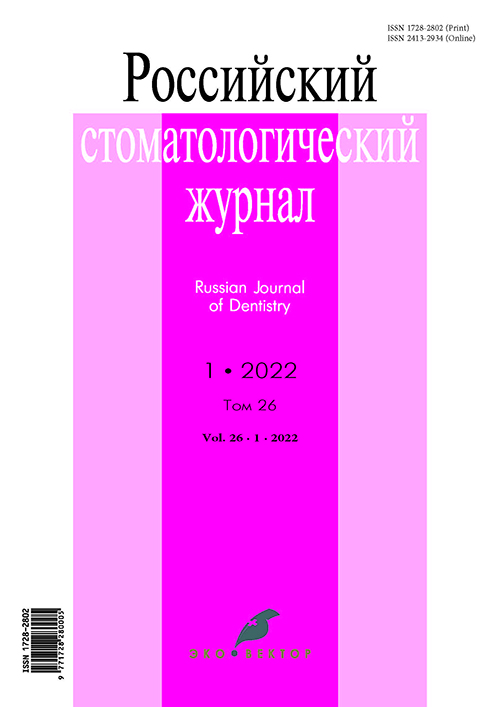Оценка потребности в ортодонтическом лечении детей, оставшихся без попечения родителей
- Авторы: Ахмедова С.К.1, Слабковская А.Б.1, Магомедов Р.Р.1, Морозова Н.В.1, Терехина Н.В.2, Дробышева Л.А.1
-
Учреждения:
- Московский государственный медико-стоматологический университет им. А.И. Евдокимова
- Центр семейного устройства при Марфо-Мариинской обители «Милосердие»
- Выпуск: Том 26, № 1 (2022)
- Страницы: 49-56
- Раздел: Клинические исследования
- Статья получена: 31.08.2022
- Статья одобрена: 31.08.2022
- Статья опубликована: 31.08.2022
- URL: https://rjdentistry.com/1728-2802/article/view/110724
- DOI: https://doi.org/10.17816/1728-2802-2022-26-1-49-56
- ID: 110724
Цитировать
Полный текст
Аннотация
Актуальность. Ортодонтическое лечение приводит не только к нормализации функции зубочелюстной системы, но и к изменению эстетики улыбки, что способствует повышению самооценки человека. По уровню нервно-психического развития в группу здоровых по коэффициенту психического развития входит около 6% детей-сирот, в группу риска и патологии — 94% воспитанников детского дома с ретардацией сенсорной, моторной, эмоциональной, поведенческой и познавательной сфер.
Цель — оценка психологического статуса детей, оставшихся без попечения родителей, на основании теста «Рисунок человека».
Материал и методы. Проведено тестирование 44 детей — воспитанников детского дома в возрасте 7–17 лет. Для оценки психологического статуса использовали тест «Рисунок человека».
Результаты. Определено, что сложные жизненные обстоятельства приводят к особенностям развития детей. Однако сохраняется стремление к социальному общению, ценится эстетика внешнего вида, возрастает желание произвести впечатление. Это свидетельствует о необходимости не только работать над психологическим состоянием детей, оставшихся без попечения родителей, но и воспитывать у них правильное отношение к здоровью и красоте, создавать возможности для совершенствования себя с помощью различных специалистов (стоматологов, ортодонтов, дерматологов и т. д.), что будет способствовать возрастанию самооценки.
Заключение. Проведенные исследования демонстрируют потребность детей, оставшихся без попечения родителей, в социальной коммуникации. Большое значение придается эстетике лица и зубов. Стоматологи могут способствовать успешной адаптации детей-сирот в обществе, обращая внимание при лечении не только на здоровье зубочелюстной системы, но и на красоту улыбки. Ортодонтическое лечение может помочь в воспитании у детей-сирот необходимых для их социализации качеств.
Полный текст
Об авторах
Сиясат Курбановна Ахмедова
Московский государственный медико-стоматологический университет им. А.И. Евдокимова
Автор, ответственный за переписку.
Email: siyasat.akhmedova@gmail.com
Россия, Москва
Анна Борисовна Слабковская
Московский государственный медико-стоматологический университет им. А.И. Евдокимова
Email: slabkovskaya.ann@mail.ru
д-р мед. наук, профессор
Россия, МоскваРаджаб Рамазанович Магомедов
Московский государственный медико-стоматологический университет им. А.И. Евдокимова
Email: dr.radzhab.magomedov@gmail.com
Россия, Москва
Наталья Викторовна Морозова
Московский государственный медико-стоматологический университет им. А.И. Евдокимова
Email: nmorozka72@mail.ru
канд. мед. наук
Россия, МоскваНадежда Владимировна Терехина
Центр семейного устройства при Марфо-Мариинской обители «Милосердие»
Email: n.tere73@yandex.ru
Россия, Москва
Лия Алексеевна Дробышева
Московский государственный медико-стоматологический университет им. А.И. Евдокимова
Email: liyaliya989898@gmail.com
Россия, Москва
Список литературы
- Доскин В.А., Тонкова-Ямпольская Р.В. Новый метод реабилитации детей с различными нарушениями поведения // Вопросы современной педиатрии. 2003. Т. 2, № 2. С. 84–85.
- Конова С.Р. Состояние здоровья детей и совершенствование медицинской помощи в условиях первичного звена здравоохранения: дис. ... д-ра мед. наук. Москва, 2007.
- Альбицкий В.Ю., Баранов A.A., Камаев И.А., Резайкин В.И. Часто болеющие дети актуальная проблема социальной педиатрии // Социальные и организационные проблемы педиатрии. Москва: Династия, 2003. С. 233–252.
- Березовский И.В. Социально-гигиеническая характеристика детей, воспитывающихся в детских домах // Здравоохранение Российской Федерации. 1994. № 2. С.23–25.
- Лещенко М.В., Тонкова-Ямпольская Р.В., Фрухт Э.Л. Состояние здоровья и развития воспитанников домов ребенка // Российский педиатрический журнал. 2000. № 1. С.48–49.
- Мухамедрахимов Р.Ж. Мать и младенец: психологическое взаимодействие. Санкт-Петербург, 2003. 286 с.
- Бондарь В.И. Основные тенденции медицинской реабилитации в домах ребенка // Медицинская помощь. 1996. № 5. С. 18–20.
- Развитие и воспитание детей в домах ребенка / под ред. В.А. Доскина, З.С. Макаровой. Москва: Владос-Пресс, 2007. 375 с.
- Павликов А.В. Соматический и нервно-психический статус детей-воспитанников Дома ребенка: дис. ... канд. мед. наук. Москва, 2010.
- Венгер А.Л. Психологические рисуночные тесты: иллюстрированное руководство. Москва: Владос-Пресс, 2003.
Дополнительные файлы


















